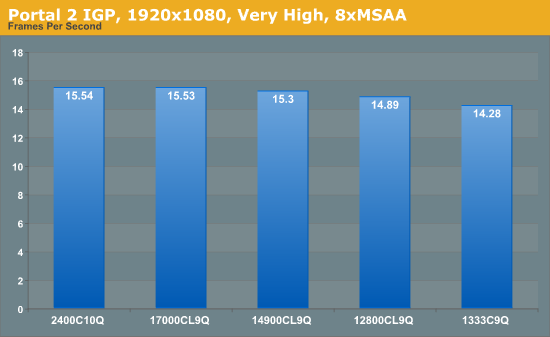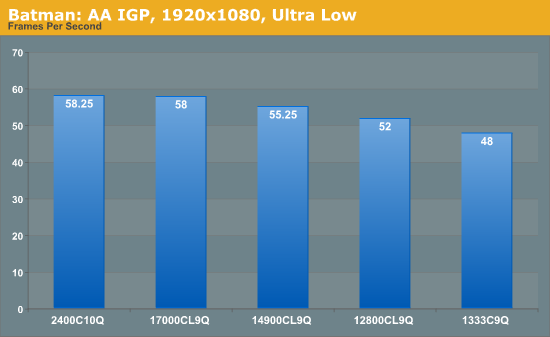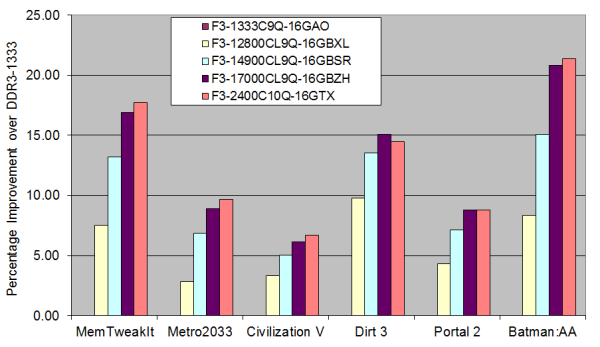Memory Performance: 16GB DDR3-1333 to DDR3-2400 on Ivy Bridge IGP with G.Skill
by Ian Cutress on October 18, 2012 12:00 PM EST- Posted in
- Memory
- G.Skill
- Ivy Bridge
- DDR3
Portal 2
A stalwart of the Source engine, Portal 2 is the big hit of 2011 following on from the original award-winning Portal. In our testing suite, Portal 2 performance should be indicative of CS:GO performance to a certain extent. Here we test Portal 2 at 1920x1080 with High/Very High graphical settings.

Portal 2 mirrors previous testing, albeit our frame rate increases as a percentage are not that great – 1333 to 1600 is a 4.3% increase, but 1333 to 2400 is only an 8.8% increase.
Batman Arkham Asylum
Made in 2009, Batman:AA uses the Unreal Engine 3 to create what was called “the Most Critically Acclaimed Superhero Game Ever”, awarded in the Guinness World Record books with an average score of 91.67 from reviewers. The game boasts several awards including a BAFTA. Here we use the in-game benchmark while at the lowest specification settings without PhysX at 1920x1080. Results are reported to the nearest FPS, and as such we take 4 runs and take the average value of the final three, as the first result is sometimes +33% more than normal.

Batman: AA represents some of the best increases of any application in our testing. Jumps from 1333 C9 to 1600 C9 and 1866 C9 gives an 8% then another 7% boost, ending with a 21% increase in frame rates moving from 1333 C9 to 2400 C10.
Overall IGP Results
Taking all our IGP results gives us the following graph:
The only game that beats the MemTweakIt predictions is Batman: AA, but most games follow the similar shape of increases just scaled differently. Bearing in mind the price differences between the kits, if IGP is your goal then either the 1600 C9 or 1866 C9 seem best in terms of bang-for-buck, but 2133 C9 will provide extra performance if the budget stretches that far.











114 Comments
View All Comments
svdb - Tuesday, October 23, 2012 - link
This article is pointless and debating is futile. Everybody knows that ORANGE memory modules are always faster than BLACK one, but not as fast as RED ones! Duh...The same with cars...
jonjonjonj - Friday, October 26, 2012 - link
you keep saying that a big part of the heat sinks are too "prevent the competition from knowing what ICs are under the hood". do you really think if a competitor or anyone for that matter who wanted to know what ICs were being used are going to say damn we cant find out what the ICs are because the $45 memory has a heat sink? im pretty sure they are going to buy a kit and rip them apart.editorsorgtfo - Tuesday, October 14, 2014 - link
Sean, what a willie-brained banger-spanker you are! You probably still piss in your shorts when you discover that someone you've irked has smeared buggers on the screen of your monitor. "No one gives a shit about APU you moron......these are desktop tests!" I, for one, give a shit about APUs, you lummox, since I am building a top-quality box around an A10 7850K and a G1.Sniper A88X. Gamers who yank a joystick with one hand and wank off with the other aren't the only people that want a kickin' computer. My entire life isn't geared toward FPS, RTS or T, or MMORPG pursuits, nor do I do anything else that is graphics-processing intensive, like video editing, rendering, Bitcoin mining, etc., etc., so I don't need high-powered graphics, beyond what AMD's Dual Graphics with a Radeon R7 250 will achieve. My intent is to use my new APU machine for audio recording, and I'd like to be able to get a really good overall picture of how a Kaveri system will behave using 16 or 32GB of various brands of DDR3 1866 or 2133 CL8 or 9 @ 1.5V or under SDRAM, possibly using AMD's RAMDisk software, with a very good (250GB or larger Samsung 840 EVO or better SSD), and preferably using audio-oriented real and synthetic benchmarks, because Intel has the computer-video-game-playing world by the goolies, and to most gamers, winning is everything, so they go with Intel, never once thinking about how less than 2 decades ago, there was a third big player in the processor world: VIA! They got squeezed out of the desktop competition by Intel and AMD, and we are the worse for it. Anyway, this is not to disparage Ian's testing and write-up for this review (good on yer, mate!), because he used what he had on hand. But you, Sean -- why don't you just keep your witless gob shut if you don't have something interesting, enlighting, thought-provoking, useful, helpful, amusing... i.e., POSITIVE! to contribute? "AMD is a decade behind Intel, in processor technology and instructions, it really doesn't matter what AMD attempts to do...." For f*ck's sake -- get an effing life, kid! Then, maybe you'd finally get laid, and someday, even have a girlfriend and a car, instead of Five-Finger Mary and a skateboard!exodius - Monday, February 2, 2015 - link
You got one of the calculations wrong:DDR3-1866 11-11-11 has a Cycle Time of 1.07 ns and a Bit Time of 0.536 ns
The time to read one word should be 1.08 * 11 = 11.88 ns (not 11.79)
The time to read eight words should be 11.88 + 7 * 0.536 = 15.632 ns (not 15.54)
Unless i'm missing something